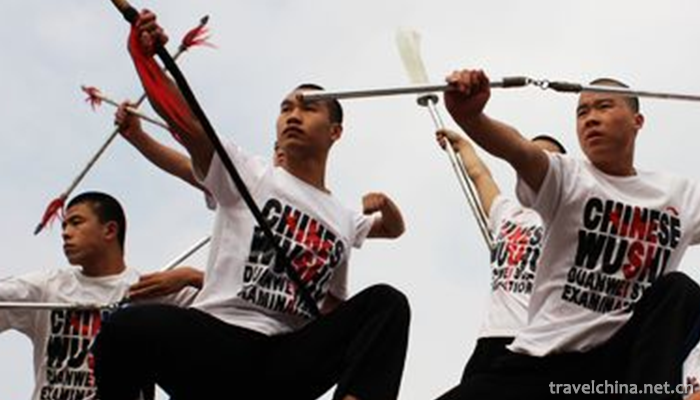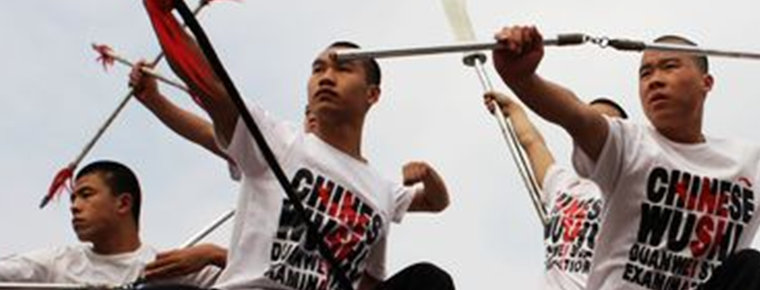Eighteen General Martial Arts
Eighteen General Martial Arts
A traditional term of Chinese Wushu, also known as "Eighteen Weapons" and "Eighteen Weapons", is commonly used in ancient Chinese operas and novels, referring to the use of various Wushu instruments and skills. The content and form of eighteen kinds of martial arts are very rich, which largely reflects the development of martial arts in that era. Modern people's understanding of "Eighteen General Martial Arts" refers to a wide range of weapons or skills.
On May 23, 2011, eighteen general martial arts were approved by the State Council to be included in the third batch of national intangible cultural heritage list.
evolution
As a military term, it appeared in military books, and "Eighteen General Martial Arts" was first found in the Collection of Cuiwei North by Huayue in the Southern Song Dynasty. The seven chapters of the book "Eight out of ten martial arts, and bow first", but did not give the specific content of "Eighteen general martial arts".
At the end of Yuan Dynasty and the beginning of Ming Dynasty, the second chapter of Shi Nai'an's Water Margin in Ming Dynasty said, "Shi Jin asks Wang Jiaotou every day to point out eighteen kinds of martial arts and teach them one by one from the beginning. What are the eighteen kinds of martial arts? Spears, hammers, bows, braces, swords, chains, axes, cymbals and halberds, batons and forks."
During the Wanli period of the late Ming Dynasty, the specific content of "Eighteen General Martial Arts" was expressed in a new way: "One bow, two crossbows, three guns, four knives, five swords, six spears, seven shields, eight axes, nine indigo, ten halberds, eleven whips, twelve bracelets, thirteen picks, fourteen covers, fifteen forks, sixteen palladium heads, seventeen cotton ropes, eighteen white strikes". "White Fight" means unarmed fighting. Boxing has always been paid attention to in Wushu practice. Ming Qi Jiguang pointed out in "Jixian Xinshu Quijie Essential Chapter of Quan Jingjie" that "Boxing seems to be unprepared for the war, but it is also the door for beginners to learn to enter the art by moving their hands and feet and being diligent in their limbs." Since then, although the contents of the eighteen general martial arts have changed, they are basically the same as this.
Since the Qing Dynasty, the eighteen kinds of martial arts have four main statements:
1. Refers to knives, guns, swords, halberds, legs, sticks, forks, rakes, whips, maces, hammers, axes, hooks, sickles, picks, crutches, bows and arrows, rattan cards.
2. Same as the arrangement, the last three items changed into generations, bows and arrows.
3. Refers to "nine long and nine short". Nine lengths are guns, halberds, sticks, indigo, forks, legs, hooks, mortise and rings; nine short are knives, swords, crutches, axes, whips, maces, hammers, sticks and pestles. The disappearance of bows and arrows of long-range weapons and cards or rattan cards of defensive weapons also reflects that modern practitioners are not good at bows and arrows and only teach routines.
4. It refers to 18 kinds of weapons called knives, guns, swords, halberds, axes, cymbals, hooks, forks, whips, maces, hammers, grasps, boring, sticks, bangs, sticks, crutches, meteor hammers and so on. This is also an arrangement accepted by most people today.
Significance
From this we can see that the so-called "eighteen general" is not limited to eighteen weapons, but an overview of various ancient martial arts. In fact, the Cold Weapon Age produced many weapons, far more than the "eighteen-size". During the late Qing Dynasty and the Republic of China, "Eighteen Weapons" became the necessary display of all martial arts halls, and became one of the symbols of Chinese martial arts and martial arts halls.


-
1.The Museum of the Imperial Palace of Manchukuo
The Museum of the Imperial Palace of “Manchukuo†is located in Guangfubei Road, Kuancheng District, Changchun City. It is a Palace Ruins Museum built on the site of the Puppet Manchu Palac
Time 2018-12-05 -
2.Rushan Yintan Tourist Resort
Yintan Tourist Resort is located on the southeast coast of Rushan City, Weihai, Shandong Province. It connects Weihai to the east, Yantai to the north, Qingdao to the West and Huanghai to the south
Time 2018-12-22 -
3.Kizil Gaha Peak Sui
Located on the east side of Saltwater Valley in the northwest of Kuqa County Town, Kizil Mahabi is a towering ancient military building with the meaning of "old red mouth" or "red sentr
Time 2018-12-23 -
4.East China Bailey Winery
East China Wine Manor is located in Jiulongpo, Nanlongkou, Laoshan, Qingdao. It is the first European Wine Manor in China built strictly according to the European Wine Manor Model
Time 2018-12-26 -
5.Scenic Spots of the Three Gorges of the Yellow River
The Three Gorges Scenic Area of the Yellow River, the national AAAA-level tourist attraction, the home of Chinese dinosaurs, painted pottery, flowers and Nuo culture.
Time 2019-01-18 -
6.Eighteen Sayings on Tibetan Wedding Banquet
The Eighteenth Tibetan Wedding Banquet is a kind of folk oral literature spread in the Tibetan inhabited areas of the eastern agricultural region of Qinghai Province. Its manifestation is the eighteen
Time 2019-04-07 -
7.Forty eight Zhai Song Festival
The forty-eighth Village Song Festival is a northern Dong dialect Song Festival in Tianzhu County, Guizhou Province, China. It is a traditional national festival featuring Dong
Time 2019-05-01 -
8.Maoshan chant
Maoshan chant is a traditional folk song originating in Maoshan area of Xinghua City, Jiangsu Province. It is a kind of folk song that people in Maoshan use chant form with chant words to stimulate em
Time 2019-05-28 -
9.Sigangli
Lincang City is located in the southwest of Yunnan Province, which is adjacent to the west, southwest of Yunnan and Myanmar. It has jurisdiction over one district, four counties and three autonomous c
Time 2019-06-16 -
10.Chengdu Jinsha Site Museum
Chengdu Jinsha Site Museum, a national AAAA tourist attraction, is located at No.2 Jinsha Ruins Road, Qingyang District, Chengdu City, Sichuan Province. It covers an area of 456 Mu and a building area of 38000 square meters.
Time 2020-11-06 -
11.Suining first industry
In 2019, the total output value of agriculture, forestry, animal husbandry and fishery in Suining will reach 30.998 billion yuan, an increase of 3.4% over the previous year.
Time 2020-12-16 -
12.Climate in Guangan
Guang'an City belongs to the humid monsoon climate zone of middle subtropical zone, with mild climate and suitable for agriculture in four seasons. In summer, it is affected by the Pacific subtropical high, the Qinghai Tibet high, the plateau fluctuation, and the southwest w
Time 2020-12-19